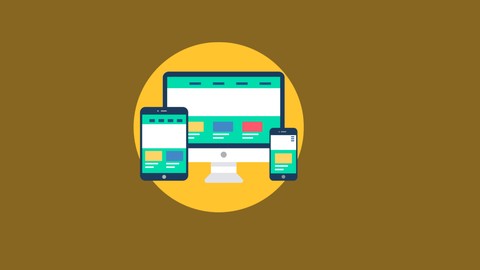
PHP Programming Fundamentals for beginners
PHP Programming Fundamentals for beginners, available at $54.99, with 61 lectures, and has 1 subscribers.
You will learn about Understand the basics of web development and the difference between client-side and server-side scripting. Gain a foundational understanding of PHP as a server-side scripting language. Familiarize themselves with the Apache web server and MySQL database, essential components of many web applications. Navigate and utilize PhpMyAdmin for managing MySQL databases. Set up a local development environment using XAMPP, including starting and managing servers. Test and verify the functionality of a local web server for development purposes. Write and understand basic PHP syntax, including proper code commenting. Identify and work with different PHP data types, such as strings, integers, and arrays. Use PHP print and echo statements to display output. Declare and use PHP variables, understanding different scopes like local, global, and static. Apply PHP operators to perform arithmetic, comparison, string operations, and logical evaluations. Implement conditional statements in PHP, including IF, ELSE, ELSEIF, and SWITCH, to control the flow of the program. Create and use loops in PHP, including WHILE, DO WHILE, FOR, and FOREACH loops, for repeated execution of code blocks. Understand and manipulate PHP arrays, including indexed, associative, and multidimensional arrays. Develop and utilize PHP functions to organize and reuse code, including passing arguments and returning values. Work with PHP string functions to manipulate and format strings. Design and create a MySQL database and tables for storing data used in a web application. Connect a PHP script to a MySQL database to interact with the database from a web application. Develop a registration and login system using PHP and MySQL, managing user sessions for authentication. Create and style HTML forms for user registration and login, ensuring they are user-friendly and functional. Build a dynamic dashboard page that displays user-specific content after logging in. Test and troubleshoot the registration and login system, ensuring its functionality and security in real-world scenarios. This course is ideal for individuals who are Aspiring Web Developers: Individuals looking to start a career in web development and wanting to gain a solid foundation in server-side scripting with PHP. or Beginner Programmers: Those who have some basic understanding of programming concepts and are looking to expand their skills into web development, particularly in backend technologies. or Students and IT Learners: Students studying computer science, information technology, or related fields who need to learn PHP as part of their coursework or to enhance their programming knowledge. or Freelancers and Entrepreneurs: Individuals interested in building their own websites, blogs, or small web applications without relying on third-party developers. or Tech Enthusiasts and Hobbyists: People who have a passion for technology and programming and want to learn PHP to create personal projects, such as web apps, portfolios, or small business websites or Front-End Developers: Developers who already have experience in HTML, CSS, and JavaScript and want to expand their skill set to include server-side programming with PHP. or IT Professionals: Professionals in the IT field who need to add PHP development to their skill set to handle web projects or support existing PHP-based applications. It is particularly useful for Aspiring Web Developers: Individuals looking to start a career in web development and wanting to gain a solid foundation in server-side scripting with PHP. or Beginner Programmers: Those who have some basic understanding of programming concepts and are looking to expand their skills into web development, particularly in backend technologies. or Students and IT Learners: Students studying computer science, information technology, or related fields who need to learn PHP as part of their coursework or to enhance their programming knowledge. or Freelancers and Entrepreneurs: Individuals interested in building their own websites, blogs, or small web applications without relying on third-party developers. or Tech Enthusiasts and Hobbyists: People who have a passion for technology and programming and want to learn PHP to create personal projects, such as web apps, portfolios, or small business websites or Front-End Developers: Developers who already have experience in HTML, CSS, and JavaScript and want to expand their skill set to include server-side programming with PHP. or IT Professionals: Professionals in the IT field who need to add PHP development to their skill set to handle web projects or support existing PHP-based applications.
Enroll now: PHP Programming Fundamentals for beginners
Summary
Title: PHP Programming Fundamentals for beginners
Price: $54.99
Number of Lectures: 61
Number of Published Lectures: 61
Number of Curriculum Items: 61
Number of Published Curriculum Objects: 61
Original Price: $27.99
Quality Status: approved
Status: Live
What You Will Learn
- Understand the basics of web development and the difference between client-side and server-side scripting.
- Gain a foundational understanding of PHP as a server-side scripting language.
- Familiarize themselves with the Apache web server and MySQL database, essential components of many web applications.
- Navigate and utilize PhpMyAdmin for managing MySQL databases.
- Set up a local development environment using XAMPP, including starting and managing servers.
- Test and verify the functionality of a local web server for development purposes.
- Write and understand basic PHP syntax, including proper code commenting.
- Identify and work with different PHP data types, such as strings, integers, and arrays.
- Use PHP print and echo statements to display output.
- Declare and use PHP variables, understanding different scopes like local, global, and static.
- Apply PHP operators to perform arithmetic, comparison, string operations, and logical evaluations.
- Implement conditional statements in PHP, including IF, ELSE, ELSEIF, and SWITCH, to control the flow of the program.
- Create and use loops in PHP, including WHILE, DO WHILE, FOR, and FOREACH loops, for repeated execution of code blocks.
- Understand and manipulate PHP arrays, including indexed, associative, and multidimensional arrays.
- Develop and utilize PHP functions to organize and reuse code, including passing arguments and returning values.
- Work with PHP string functions to manipulate and format strings.
- Design and create a MySQL database and tables for storing data used in a web application.
- Connect a PHP script to a MySQL database to interact with the database from a web application.
- Develop a registration and login system using PHP and MySQL, managing user sessions for authentication.
- Create and style HTML forms for user registration and login, ensuring they are user-friendly and functional.
- Build a dynamic dashboard page that displays user-specific content after logging in.
- Test and troubleshoot the registration and login system, ensuring its functionality and security in real-world scenarios.
Who Should Attend
- Aspiring Web Developers: Individuals looking to start a career in web development and wanting to gain a solid foundation in server-side scripting with PHP.
- Beginner Programmers: Those who have some basic understanding of programming concepts and are looking to expand their skills into web development, particularly in backend technologies.
- Students and IT Learners: Students studying computer science, information technology, or related fields who need to learn PHP as part of their coursework or to enhance their programming knowledge.
- Freelancers and Entrepreneurs: Individuals interested in building their own websites, blogs, or small web applications without relying on third-party developers.
- Tech Enthusiasts and Hobbyists: People who have a passion for technology and programming and want to learn PHP to create personal projects, such as web apps, portfolios, or small business websites
- Front-End Developers: Developers who already have experience in HTML, CSS, and JavaScript and want to expand their skill set to include server-side programming with PHP.
- IT Professionals: Professionals in the IT field who need to add PHP development to their skill set to handle web projects or support existing PHP-based applications.
Target Audiences
- Aspiring Web Developers: Individuals looking to start a career in web development and wanting to gain a solid foundation in server-side scripting with PHP.
- Beginner Programmers: Those who have some basic understanding of programming concepts and are looking to expand their skills into web development, particularly in backend technologies.
- Students and IT Learners: Students studying computer science, information technology, or related fields who need to learn PHP as part of their coursework or to enhance their programming knowledge.
- Freelancers and Entrepreneurs: Individuals interested in building their own websites, blogs, or small web applications without relying on third-party developers.
- Tech Enthusiasts and Hobbyists: People who have a passion for technology and programming and want to learn PHP to create personal projects, such as web apps, portfolios, or small business websites
- Front-End Developers: Developers who already have experience in HTML, CSS, and JavaScript and want to expand their skill set to include server-side programming with PHP.
- IT Professionals: Professionals in the IT field who need to add PHP development to their skill set to handle web projects or support existing PHP-based applications.
Are you ready to dive into the world of web development and learn how to build dynamic websites and applications? The “PHP Programming Fundamentals for Beginners” course is designed to take you from a complete novice to a confident PHP programmer. Whether you’re an aspiring web developer, a student, or a tech enthusiast, this course will provide you with the foundational skills needed to create powerful and interactive websites using PHP, one of the most popular server-side scripting languages.
What You Will Learn
This comprehensive course begins with an overview of web development, where you’ll explore how websites work and the differences between client-side and server-side scripting. You’ll gain a clear understanding of PHP’s role in the web development ecosystem and learn about essential technologies like Apache, MySQL, and PhpMyAdmin.
Setting up your development environment is crucial, and we’ll guide you through the process of installing and configuring XAMPP, a local server environment that includes Apache, MySQL, and PHP. You’ll learn how to start and manage these servers, ensuring that your local development environment is ready for action. We’ll also introduce you to popular text editors, helping you choose and install the one that best suits your needs for PHP development.
The core of the course focuses on PHP syntax and data types. You’ll master basic PHP syntax, understand how to use code comments effectively, and explore various data types such as strings, integers, and arrays. We’ll cover essential PHP concepts like variables, operators, and conditional statements, providing you with the tools to write clear and logical code.
As you progress, you’ll dive into more advanced topics, including loops, arrays, and functions. You’ll learn how to create and manipulate arrays, utilize different loop structures, and build reusable functions. Our practical examples and hands-on exercises will reinforce your learning, ensuring that you can apply these concepts in real-world scenarios.
One of the highlights of this course is the project where you will build a complete registration and login system using PHP and MySQL. This project will take you through the entire process, from creating a database and connecting it to PHP, to designing and styling registration and login forms. You’ll learn how to manage user sessions, create a user dashboard, and implement secure logout functionality. By the end of this project, you’ll have a fully functional user authentication system that you can integrate into any website.
Why Take This Course?
This course is tailored for beginners, with no prior PHP experience required. Our step-by-step approach ensures that you understand each concept thoroughly before moving on to the next. Whether you’re looking to start a new career in web development, enhance your current skill set, or simply build your own personal projects, this course will provide you with the knowledge and confidence to succeed.
Throughout the course, you’ll have access to engaging video lectures, downloadable resources, and quizzes to test your knowledge. By the end of the course, you will have a strong foundation in PHP programming and will be ready to tackle more advanced topics or start developing your own PHP-based applications.
Join us in the “PHP Programming Fundamentals for Beginners” course and start your journey to becoming a skilled PHP developer today!
Course Curriculum
Chapter 1: Overview of Web Development
Lecture 1: Introduction
Lecture 2: Understanding how websites work
Lecture 3: Introduction to server-side vs. client-side scripting
Lecture 4: Introduction to PHP
Lecture 5: Introduction to Apache, MySQL
Lecture 6: What is PHPMyAdmin
Chapter 2: Setting Up the Development Environment
Lecture 1: Installing XAMPP (Local Server)
Lecture 2: Exploring XAMPP Control Panel
Lecture 3: Starting the Servers
Lecture 4: Testing the web server
Lecture 5: Text Editors
Lecture 6: Installing Text Editor
Chapter 3: PHP Syntax and Data Types
Lecture 1: Basic PHP Syntax
Lecture 2: Using PHP Code Comments
Lecture 3: PHP Data Types
Lecture 4: Examples of PHP Data Types
Lecture 5: Print Vs Echo Statements
Chapter 4: PHP Variables
Lecture 1: PHP Variables
Lecture 2: Creating Variables
Lecture 3: Introduction to variable scopes
Lecture 4: PHP Local Variable Scope
Lecture 5: PHP Global Variable Scope
Lecture 6: PHP Static Variable Scope
Chapter 5: PHP Operators
Lecture 1: Introduction to PHP Operators
Lecture 2: PHP Arithmetic Operators
Lecture 3: PHP Assignment Operator
Lecture 4: PHP Comparison Operator
Lecture 5: PHP Increment and Decrement Operators
Lecture 6: PHP Logical Operators
Lecture 7: PHP String Operators
Chapter 6: Conditional Statements
Lecture 1: Introduction to conditional statements
Lecture 2: PHP IF statements
Lecture 3: PHP IF ELSE Statements
Lecture 4: PHP IF ELSEIF ELSE Statement
Lecture 5: PHP Switch Statement
Chapter 7: Loops in PHP
Lecture 1: Introduction to Loops
Lecture 2: PHP While Loops
Lecture 3: PHP DO While Loops
Lecture 4: PHP For Loops
Lecture 5: PHP Foreach Loop
Chapter 8: PHP Arrays
Lecture 1: Introduction to Arrays
Lecture 2: PHP Indexed Array
Lecture 3: PHP Associative Arrays
Lecture 4: PHP Multidimensional Arrays
Chapter 9: PHP Functions
Lecture 1: Introduction to PHP Functions
Lecture 2: PHP Function Arguments
Lecture 3: PHP Returning Function Arguments
Lecture 4: PHP String Functions
Lecture 5: PHP String Functions continued
Chapter 10: Create a Registration and Login System with PHP and MySQL
Lecture 1: Create a Database and Database Table
Lecture 2: Connect to the Database
Lecture 3: Creating a directory for web pages
Lecture 4: Create Session for Logged in User
Lecture 5: Create a Registration Form: Part 1
Lecture 6: Create a Registration Form: Part 2
Lecture 7: Create a Login Form
Lecture 8: Create a Dashboard Page
Lecture 9: Create a Logout (Destroy session)
Lecture 10: Styling the forms: Part 1
Lecture 11: Styling the forms: Part 2
Lecture 12: Testing the registration and signing system
Instructors
-
247 Learning
An investment in knowledge pays the best interest
Rating Distribution
- 1 stars: 0 votes
- 2 stars: 0 votes
- 3 stars: 0 votes
- 4 stars: 0 votes
- 5 stars: 0 votes
Frequently Asked Questions
How long do I have access to the course materials?
You can view and review the lecture materials indefinitely, like an on-demand channel.
Can I take my courses with me wherever I go?
Definitely! If you have an internet connection, courses on Udemy are available on any device at any time. If you don’t have an internet connection, some instructors also let their students download course lectures. That’s up to the instructor though, so make sure you get on their good side!
You may also like
- Best Video Editing Courses to Learn in February 2025
- Best Music Production Courses to Learn in February 2025
- Best Animation Courses to Learn in February 2025
- Best Digital Illustration Courses to Learn in February 2025
- Best Renewable Energy Courses to Learn in February 2025
- Best Sustainable Living Courses to Learn in February 2025
- Best Ethical AI Courses to Learn in February 2025
- Best Cybersecurity Fundamentals Courses to Learn in February 2025
- Best Smart Home Technology Courses to Learn in February 2025
- Best Holistic Health Courses to Learn in February 2025
- Best Nutrition And Diet Planning Courses to Learn in February 2025
- Best Yoga Instruction Courses to Learn in February 2025
- Best Stress Management Courses to Learn in February 2025
- Best Mindfulness Meditation Courses to Learn in February 2025
- Best Life Coaching Courses to Learn in February 2025
- Best Career Development Courses to Learn in February 2025
- Best Relationship Building Courses to Learn in February 2025
- Best Parenting Skills Courses to Learn in February 2025
- Best Home Improvement Courses to Learn in February 2025
- Best Gardening Courses to Learn in February 2025






















